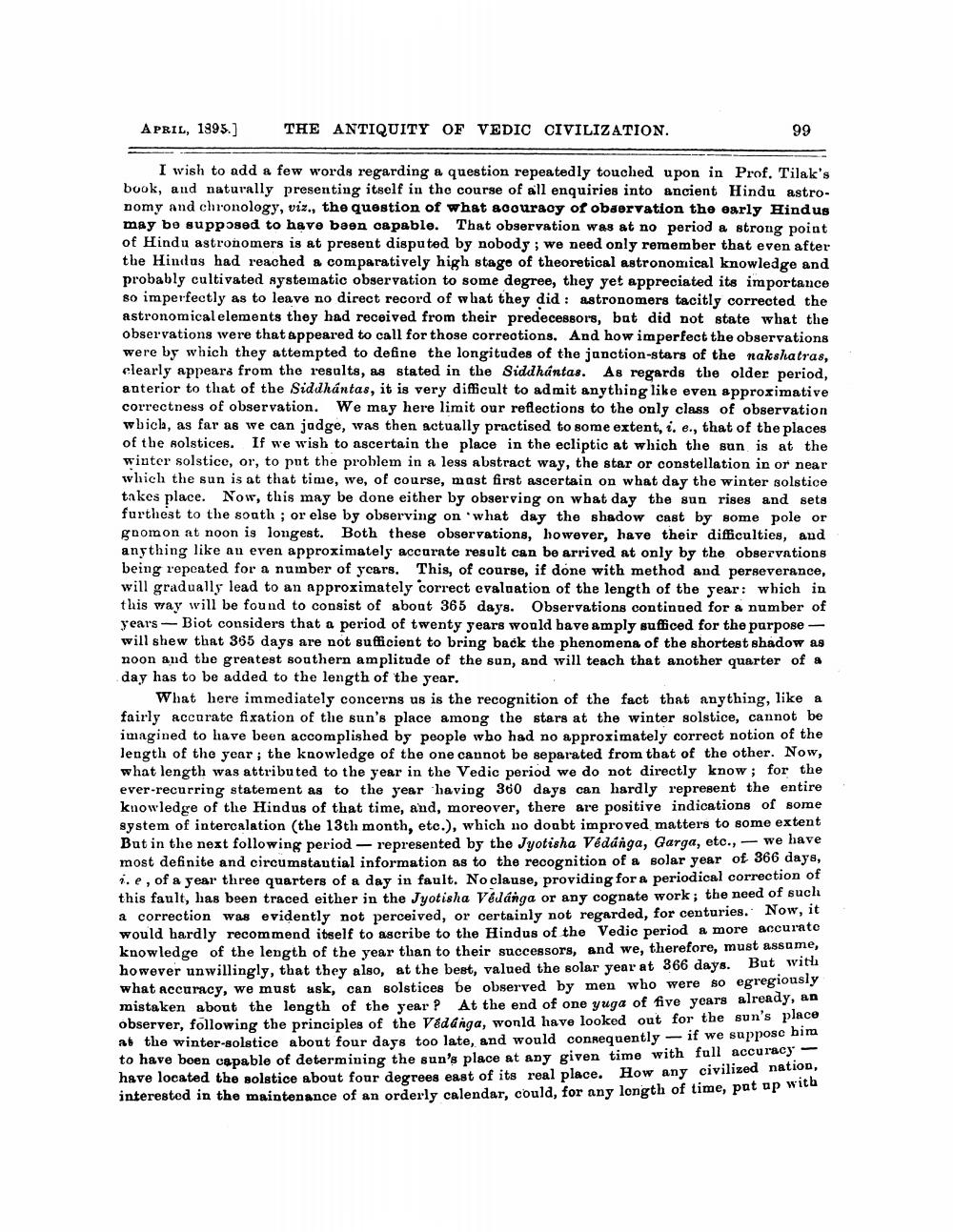________________
APRIL, 1995.]
THE ANTIQUITY OF VEDIC CIVILIZATION.
99
I wish to add a few words regarding a question repeatedly touched upon in Prof. Tilak's book, and naturally presenting itself in the course of all enquiries into ancient Hindu astronomy and chronology, viz., the question of what acouracy of observation the early Hindus may be supposed to have been capable. That observation was at no period a strong point of Hindu astronomers is at present disputed by nobody; we need only remember that even after the Hindus had reached a comparatively high stage of theoretical astronomical knowledge and probably cultivated systematic observation to some degree, they yet appreciated its importance so imperfectly as to leave no direct record of what they did : astronomers tacitly corrected the astronomical elements they had received from their predecessors, but did not state what the observations were that appeared to call for those corrections. And how imperfect the observations were by which they attempted to define the longitudes of the junction-stars of the nakshatras, elearly appears from the results, as stated in the Siddhantas. As regards the older period, anterior to that of the Siddhantas, it is very difficult to admit anything like even approximative correctness of observation. We may here limit our reflections to the only class of observation wbicla, as far as we can jadge, was then actually practised to some extent, i. e., that of the places of the solstices. If we wish to ascertain the place in the ecliptic at which the sun is at the winter solstice, or, to put the problem in a less abstract way, the star or constellation in or near which the sun is at that time, we, of course, mast first ascertain on what day the winter solstice takes place. Now, this may be done either by observing on what day the sun rises and sets furthest to the soath ; or else by observing on what day the shadow cast by some pole or geomon at noon is longest. Both these observations, however, have their difficulties, and anything like an even approximately accurate result can be arrived at only by the observations being repeated for a number of years. This, of course, if done with method and perseverance, will gradually lead to an approximately correct evaluation of the length of the year: which in this way will be found to consist of about 365 days. Observations continued for a number of years - Biot considers that a period of twenty years would have amply sufficed for the purpose - will shew that 365 days are not sufficient to bring back the phenomena of the shortest shadow as noon and the greatest southern amplitude of the sun, and will teach that another quarter of a day has to be added to the length of the year.
What here immediately concerns us is the recognition of the fact that anything, like a fairly accurate fixation of the sun's place among the stars at the winter solstice, cannot be imagined to have been accomplished by people who had no approximately correct notion of the length of the year; the knowledge of the one cannot be separated from that of the other. Now, what length was attributed to the year in the Vedic period we do not directly know; for the ever-recurring statement as to the year having 360 days can hardly represent the entire knowledge of the Hindus of that time, and, moreover, there are positive indications of some system of intercalation (the 13th month, etc.), which no doubt improved matters to some extent But in the next following period - represented by the Jyotisha Védánga, Garga, etc., we have most definite and circumstantial information as to the recognition of a solar year of 366 days, i.e, of a year three quarters of a day in fault. No clause, providing for a periodical correction of this fault, has been traced either in the Jyotisha Vegánga or any cognate work; the need of such a correction was evidently not perceived, or certainly not regarded, for centuries. Now, it would hardly recommend itself to ascribe to the Hindus of the Vedic period a more accurato knowledge of the length of the year than to their successors, and we, therefore, must assume, however unwillingly, that they also, at the best, valued the solar year at 366 days. But with what accuracy, we must usk, can solstices be observed by men who were so egregiously mistaken about the length of the year ? At the end of one yuga of five years already, an observer, following the principles of the Vedanga, wonld have looked out for the sun's place at the winter-solstice about four days too late, and would consequently - if we suppose bima to have been capable of determining the sun's place at any given time with full accuracy have located the solstice about four degrees east of its real place. How any civilized nation, interested in the maintenance of an orderly calendar, could, for any longth of time, put up




